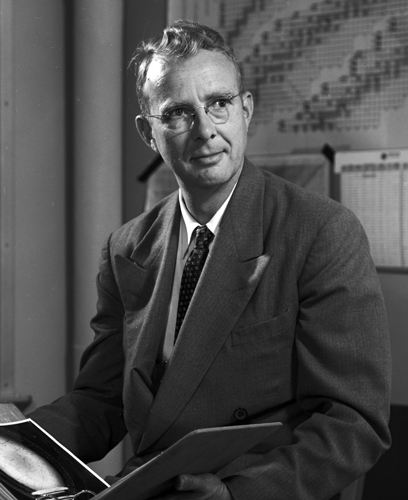At the April 2011 meeting of the American Physical Society (APS) in Anaheim, CA, the APS Forum on the History of Physics held a session on “Working With Luis Alvarez.” Alvarez, born in San Francisco in 1911, joined UC Berkeley’s Radiation Laboratory as a research fellow in 1936 and became one of Ernest Lawrence’s “boys.” Thirty-two years later he won the Nobel Prize in physics for “decisive contributions to elementary particle physics.” Alvarez’s career continued at what is now Lawrence Berkeley National Laboratory until his death in 1988. A fountain of ideas – frequently both astonishing and insightful, sometimes grandiose, occasionally outlandish, almost always off-beat – “Luie” Alvarez, as his friends often spelled the name, habitually terrorized ill-prepared students, bureaucrats, reporters, and peers but was an inspiration to generations of his colleagues.
Three men who knew Alvarez and Berkeley Lab well were invited to speak at the APS centennial celebration. Some of their reminiscences and photos can be reached from this page.
Richard Muller of Berkeley Lab’s Physics Division was Alvarez’s last graduate student and became his sounding board for new ideas. Says Muller, “He always wanted me to prove him wrong, so that he wouldn’t waste time on things destined to fail…. I was convinced he was utterly wasting his time on a project to work with his son Walter to figure out what killed the dinosaurs.” Well, not exactly. Muller’s remarks on “Working with and learning from Luis Alvarez” are included with his slide presentation, available here.
Arthur Rosenfeld, former Commissioner of the California Energy Commission, is a Distinguished Scientist Emeritus at Berkeley Lab and a guest in the Environmental Energy Technologies Division. Early in his career he worked with Alvarez to create a complex automated system for analyzing the millions of stereo photographs of particle tracks that appeared annually in the enormous liquid-hydrogen bubble chamber Alvarez had devised for the Bevatron accelerator (which resulted in his Nobel Prize). Rosenfeld then had to fill out annual “Rosenfeld Tables” of the subnuclear particles found at the Bevatron and elsewhere. Although Rosenfeld’s remarks on “Working with Luie on bubble chambers” were not recorded, the photographs he assembled can be seen here.
Morris (Moishe) Pripstein, now in the Physics Division of the National Science Foundation, remains a guest in Berkeley Lab’s Physics Division. Says Pripstein, “Luis was the most remarkable physicist I have ever worked with,” not least for “his forceful and colorful personality…. Although he created the largest research group in particle physics in the world at the time, Luis was an ardent foe of group-think, which he characterized as ‘intellectual phase-lock.’”
Illness prevented Pripstein from appearing in person at the APS, but “Working (and sparring) with Luis: some personal recollections,” his memoir of Alvarez that’s chock full of insights and anecdotes, is available here.

